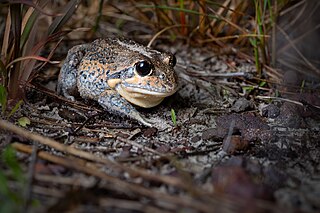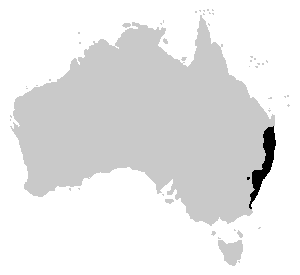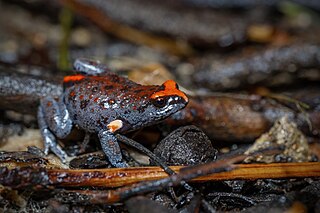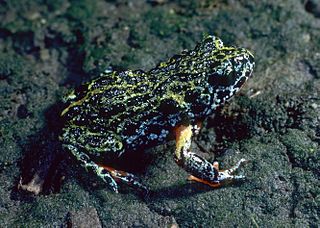
Limnodynastes dumerilii is a frog species from the family Limnodynastidae. The informal names for the species and its subspecies include eastern or southern banjo frog, and bull frog. The frog is also called the pobblebonk after its distinctive "bonk" call, which is likened to a banjo string being plucked. There are five subspecies of L. dumerilii, each with different skin coloration. The species is native to eastern Australia. There has been one occurrence in New Zealand, when tadpoles of the species were found in 1999 and destroyed.

The robust bleating tree frog, also known as Keferstein's tree frog, is a species of tree frog in the subfamily Pelodryadinae. This frog is endemic to coastal eastern Australia, where it ranges from northeastern New South Wales to the NSW/Queensland border. It has also been introduced to Lord Howe Island.

Rheobatrachus, whose members are known as the gastric-brooding frogs or platypus frogs, is a genus of extinct ground-dwelling frogs native to Queensland in eastern Australia. The genus consisted of only two species, the southern and northern gastric-brooding frogs, both of which became extinct in the mid-1980s. The genus is unique because it contains the only two known frog species that incubated the prejuvenile stages of their offspring in the stomach of the mother.

The red-crowned toadlet is a species of Australian ground frog, restricted to the Sydney Basin, New South Wales. It is only found around sandstone escarpment areas around Sydney, from Ourimbah in the north, Nowra to the south and the Blue Mountains areas to the west.

The Bibron's toadlet or brown toadlet is a species of Australian ground-dwelling frog that, although having declined over much of its range, is widespread through most of New South Wales, Victoria, south-eastern Queensland, and eastern South Australia, including Kangaroo Island. Bibron's toadlet settles in a wide variety of habitats within these region but they mainly reside in dry forests, woodland, shrubland, grassland, coastal swamps, heathland, and sub-alpine areas. They deposit their eggs in leaf litters during the flooding season, which is essential for the proper development of the egg. This species has high sexual dimorphism within the species and utilizes chemosignals to attract potential mates.

The stuttering frog is a large species of frog that inhabits temperate and sub-tropical rainforest and wet sclerophyll forest in Australia.

The large toadlet or great toadlet or major toadlet is a species of ground-dwelling frog native to eastern Queensland and northern New South Wales, Australia.
Anstisia vitellina, commonly known as the orange-bellied frog, is a species of frog in the family Myobatrachidae. It is endemic to a 20 hectare area near Margaret River in Southwest Australia. It is vulnerable to extinction due to fire and the destruction of habitat caused by feral pigs.

The knife-footed frog is a species of burrowing frog in the family Hylidae. It is endemic to Australia, where it is found over a wide area in the north of the continent.
The moss froglet is a species of frog in the family Myobatrachidae. It is endemic to southern Tasmania.

The magnificent brood frog or magnificent broodfrog is a species of frog in the family Myobatrachidae. It is endemic to Queensland, Australia, and is known from near Ravenshoe in the southern Atherton Tableland and from Mount Spec in the Paluma Range. The specific name covacevichae honours Jeanette Covacevich, an Australian herpetologist.

The orange-crowned toadlet, or western toadlet, is a species of frog in the family Myobatrachidae. It is endemic to Australia. Its natural habitats are temperate shrubland, Mediterranean-type shrubby vegetation, intermittent rivers, intermittent freshwater lakes, freshwater marshes, intermittent freshwater marshes, and rocky areas.
The Strike-a-Light River, a perennial stream that is part of the Murrumbidgee catchment within the Murray–Darling basin, is located in the Snowy Monaro Regional Council area of New South Wales, Australia.

The southern toadlet, or marbled toadlet, is a species of small frog that is endemic to south-eastern Australia.
The Howard Springs toadlet, also known as the Howard River toadlet, Davies's toadlet or the Darwin sandsheet frog, is a species of small frog that is endemic to Australia. The specific epithet daviesae honours Australian herpetologist Margaret M. Davies.
Mahony's toadlet is a species of small frog that is endemic to Australia. The specific epithet honours Professor Michael Mahony of the University of Newcastle for contributions to the study of Australian frogs.

The screaming tree frog is a species of frog in the subfamily Pelodryadinae. It is endemic to southeastern Australia, east of the Great Dividing Range. It ranges from northeastern Victoria to the mid-coast of New South Wales, from Mallacoota north to Taree. This species is the "bleating tree frog" that occurs around Sydney, and is well known for its very loud call.

The southern corroboree frog is a species of Australian ground frog native to southeastern Australia.
The Mount Ballow mountain frog is a species of frog in the family Limnodynastidae. It is endemic to eastern Australia, straddling the border of Queensland and New South Wales. It is known only from the central and western McPherson Ranges, in the Gondwana Rainforests World Heritage Site.
The southern stuttering frog is a large species of frog endemic to south-eastern Australia. It is found in mid-eastern New South Wales and at least formerly Victoria, where it ranges from Carrai National Park south to East Gippsland. It inhabits temperate and subtropical rainforest, wet sclerophyll forest, and moist gullies in dry forests.












